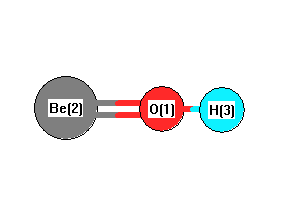Jump to
S1C2
Energy calculated at LSDA/6-31+G**
| | hartrees |
|---|
| Energy at 0K | -90.073360 |
| Energy at 298.15K | -90.072917 |
| HF Energy | -90.073360 |
| Nuclear repulsion energy | 17.562360 |
The energy at 298.15K was derived from the energy at 0K
and an integrated heat capacity that used the calculated vibrational frequencies.
Geometric Data calculated at LSDA/6-31+G**
Point Group is C∞v
Cartesians (Å)
| Atom |
x (Å) |
y (Å) |
z (Å) |
|---|
| O1 |
0.000 |
0.000 |
0.352 |
| Be2 |
0.000 |
0.000 |
-1.031 |
| H3 |
0.000 |
0.000 |
1.310 |
Atom - Atom Distances (Å)
| |
O1 |
Be2 |
H3 |
| O1 | | 1.3835 | 0.9581 |
Be2 | 1.3835 | | 2.3416 | H3 | 0.9581 | 2.3416 | |
 More geometry information
More geometry information
Calculated Bond Angles
| atom1 |
atom2 |
atom3 |
angle |
|
atom1 |
atom2 |
atom3 |
angle |
| Be2 |
O1 |
H3 |
180.000 |
|
Electronic energy levels
Charges, Dipole, Quadrupole and Polarizability
Charges from optimized geometry at LSDA/6-31+G**
Charges (e)
| Number |
Element |
Mulliken |
CHELPG |
AIM |
ESP |
| 1 |
O |
-0.424 |
|
|
|
| 2 |
Be |
0.019 |
|
|
|
| 3 |
H |
0.405 |
|
|
|
Electric dipole moments
Electric dipole components in Debye
(What's a Debye? See section
VII.A.3)
| |
x |
y |
z |
Total |
| |
0.000 |
0.000 |
1.356 |
1.356 |
| CHELPG |
|
|
|
|
| AIM |
|
|
|
|
| ESP |
|
|
|
|
Electric Quadrupole moment
Quadrupole components in D Å
| Primitive |
|---|
| | x | y | z |
|---|
| x |
-12.460 |
0.000 |
0.000 |
| y |
0.000 |
-12.460 |
0.000 |
| z |
0.000 |
0.000 |
-10.813 |
|
| Traceless |
|---|
| | x | y | z |
|---|
| x |
-0.823 |
0.000 |
0.000 |
| y |
0.000 |
-0.823 |
0.000 |
| z |
0.000 |
0.000 |
1.647 |
|
| Polar |
|---|
| 3z2-r2 | 3.294 |
|---|
| x2-y2 | 0.000 |
|---|
| xy | 0.000 |
|---|
| xz | 0.000 |
|---|
| yz | 0.000 |
|---|
|
Polarizabilities
Components of the polarizability tensor.
Units are
Å
3 (Angstrom cubed)
Change units.
| |
x |
y |
z |
| x |
4.920 |
-0.000 |
0.000 |
| y |
-0.000 |
4.914 |
0.000 |
| z |
0.000 |
0.000 |
4.943 |
<r2> (average value of r
2) Å
2
| <r2> |
14.403 |
| (<r2>)1/2 |
3.795 |
Jump to
S1C1
Energy calculated at LSDA/6-31+G**
| | hartrees |
|---|
| Energy at 0K | -90.073360 |
| Energy at 298.15K | -90.072916 |
| HF Energy | -90.073360 |
| Nuclear repulsion energy | 17.561896 |
The energy at 298.15K was derived from the energy at 0K
and an integrated heat capacity that used the calculated vibrational frequencies.
Geometric Data calculated at LSDA/6-31+G**
Point Group is C∞v
Cartesians (Å)
| Atom |
x (Å) |
y (Å) |
z (Å) |
|---|
| O1 |
0.000 |
0.000 |
0.352 |
| Be2 |
0.000 |
0.000 |
-1.032 |
| H3 |
0.000 |
0.000 |
1.310 |
Atom - Atom Distances (Å)
| |
O1 |
Be2 |
H3 |
| O1 | | 1.3835 | 0.9581 |
Be2 | 1.3835 | | 2.3416 | H3 | 0.9581 | 2.3416 | |
 More geometry information
More geometry information
Calculated Bond Angles
| atom1 |
atom2 |
atom3 |
angle |
|
atom1 |
atom2 |
atom3 |
angle |
| Be2 |
O1 |
H3 |
180.000 |
|
Electronic energy levels
Charges, Dipole, Quadrupole and Polarizability
Charges from optimized geometry at LSDA/6-31+G**
Charges (e)
| Number |
Element |
Mulliken |
CHELPG |
AIM |
ESP |
| 1 |
O |
-0.424 |
|
|
|
| 2 |
Be |
0.019 |
|
|
|
| 3 |
H |
0.405 |
|
|
|
Electric dipole moments
Electric dipole components in Debye
(What's a Debye? See section
VII.A.3)
| |
x |
y |
z |
Total |
| |
0.000 |
0.000 |
1.356 |
1.356 |
| CHELPG |
|
|
|
|
| AIM |
|
|
|
|
| ESP |
|
|
|
|
Electric Quadrupole moment
Quadrupole components in D Å
| Primitive |
|---|
| | x | y | z |
|---|
| x |
-12.460 |
0.000 |
0.000 |
| y |
0.000 |
-12.460 |
0.000 |
| z |
0.000 |
0.000 |
-10.813 |
|
| Traceless |
|---|
| | x | y | z |
|---|
| x |
-0.824 |
0.000 |
0.000 |
| y |
0.000 |
-0.824 |
0.000 |
| z |
0.000 |
0.000 |
1.647 |
|
| Polar |
|---|
| 3z2-r2 | 3.294 |
|---|
| x2-y2 | 0.000 |
|---|
| xy | 0.000 |
|---|
| xz | 0.000 |
|---|
| yz | 0.000 |
|---|
|
Polarizabilities
Components of the polarizability tensor.
Units are
Å
3 (Angstrom cubed)
Change units.
| |
x |
y |
z |
| x |
4.920 |
-0.000 |
0.000 |
| y |
-0.000 |
4.914 |
0.000 |
| z |
0.000 |
0.000 |
4.943 |
<r2> (average value of r
2) Å
2
| <r2> |
14.403 |
| (<r2>)1/2 |
3.795 |
